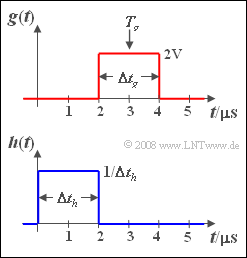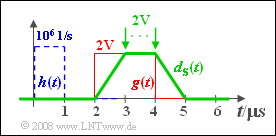Exercise 5.7: Rectangular Matched Filter
At the input of a lowpass filter with a rectangular impulse response $h(t)$ the reception signal $r(t)$ is present, which is additively composed of a pulse-shaped signal component $g(t)$ and a noise component $n(t)$. It holds:
- The pulse $g(t)$ is rectangular.
- The pulse duration is $\Delta t_g = 2 \hspace{0.08cm}\rm µ s$.
- The pulse amplitude is $g_0 = 2 \hspace{0.08cm}\rm V$.
- The center of the pulse is at $T_g = 3 \hspace{0.08cm}\rm µ s$.
- The noise $n(t)$ is white and Gaussian distributed.
- The power density is $N_0 = 4 \cdot 10^{-6} \hspace{0.08cm}\rm V^2\hspace{-0.1cm}/Hz$ with respect to the $1 \hspace{0.08cm}\rm \Omega$ resistor.
The rectangular impulse response of the filter starts at $t = 0$.
- The impulse response duration $\Delta t_h$ is freely selectable.
- The height $1/\Delta t_h$ of the impulse response is adjusted in each case so that $H(f = 0) = 1$.
Notes:
- The exercise belongs to the chapter Matched Filter.
- For the questions (1) to (6): $\Delta t_h =\Delta t_g = 2 \hspace{0.05cm}\rm µ s$ always applies.
Questions
Solution
- For the same pulse duration $(\Delta t_h =\Delta t_g)$, there is a matched filter, even if $g(t)$ and $h(t)$ differ in amplitude and temporal position.
- Thus, there is no other filter with better signal–to–noise power ratio.
- The filter with rectangular impulse response can also be interpreted as an integrator over the time duration $\Delta t_h$.
(2) The impulse response of the matched filter is: $h_{\rm MF} (t) = K_{\rm MF} \cdot g(T_{\rm D} - t).$
- The input impulse $g(t)$ is non-zero in the range from $2 \hspace{0.05cm}\rm µ s$ to $4 \hspace{0.08cm}\rm µ s$, and in the range from $-4 \hspace{0.08cm}\rm µ s$ to $-2 \hspace{0.08cm}\rm µ s$, when mirrored.
- After shifting by $4 \hspace{0.08cm}\rm µ s$, it is achieved that $g(T_{\rm D} - t)$ is, like the impulse response $h(t)$, between $0$ and $2 \hspace{0.08cm}\rm µ s$.
- From this follows: $T_\text{D, opt}\hspace{0.15cm}\underline{ =4 \hspace{0.08cm}\rm µ s}$.
(3) With $\Delta t_h =\Delta t_g = 2 \cdot 10^{-6}\hspace{0.05cm}\rm µ s$ and $g_0 = 2 \hspace{0.08cm}\rm V$, we obtain $K_{\rm MF} = 1/(\Delta t_g \cdot g_0)\hspace{0.15cm}\underline{ =0.25 \cdot 10^{6}\hspace{0.08cm}\rm (1/Vs)}$.
(4) The energy of the pulse $g(t)$ is $E_g = g_0^2 \cdot \Delta t_g = 8 \cdot 10^{-6}\hspace{0.05cm}\rm V^2s$.
- From this it follows for the maximum S/N ratio:
- $$\rho _d (T_{{\rm{D, \hspace{0.08cm}opt}}} ) = \frac{2 \cdot E_g }{N_0 } = \frac{{2 \cdot 8 \cdot 10^{ - 6} \;{\rm{V}}^2 {\rm{s}}}}{{4 \cdot 10^{ - 6} \;{\rm{V}}^2 /{\rm{Hz}}}}\hspace{0.15cm}\underline{ = 4}.$$
(5) The matched filter output pulse $d_{\rm S}(t)$ is triangular between $2 \hspace{0.05cm}\rm µ s$ and $6 \hspace{0.05cm}\rm µ s$.
- The maximum $g_0\hspace{0.15cm}\underline{= 2 \hspace{0.08cm}\rm V}$ is at $T_\text{D, opt} =4 \hspace{0.05cm}\rm µ s$.
- The noise power is given by:
- $$\sigma _d ^2 = \frac{N_0 }{2 \cdot \Delta t_h } \hspace{0.15 cm}\underline{= 1\;{\rm{V}}^2} .$$
- Using these two quantities, we can calculate the maximum S/N ratio:
- $$\rho _d (T_{{\rm{D, \hspace{0.08cm}opt}}} ) = \frac{{d_{\rm S} (T_{{\rm{D, \hspace{0.05cm}opt}}} )^2}}{\sigma _d ^2 } = \frac{({2\;{\rm{V}})^2 }}{{1\;{\rm{V}}^2 }} = 4.$$
(6) From the above diagram, one can see that now $d_{\rm S}(T_\text{D})$ is only half as large, namely $1 \hspace{0.08cm}\rm V$.
- Thus for $T_\text{D} =3 \hspace{0.08cm}\rm µ s$ the S/N ratio is smaller by a factor of $4$, i.e. $\rho _d (T_{{\rm{D}}} )\hspace{0.15 cm}\underline{=1}$.
(7) Solutions 1, 3 and 4 are correct:
- The diagram shows that now the output pulse $d_{\rm S}(t)$ is trapezoidal.
- In the range from $3 \hspace{0.05cm}\rm µ s$ to $4 \hspace{0.05cm}\rm µ s$ the pulse $d_{\rm S}(t)$ is constantly equal to $g_0= 2 \hspace{0.08cm}\rm V$.
- Because of the only half as wide impulse response $h(t)$, the frequency response $H(f)$ is more broadband by a factor of $2$ and thus the noise power is larger:
- $$\sigma_d ^2 = \frac{N_0 }{2} \cdot \int_{ - \infty }^{ + \infty } {h^2 (t)\,{\rm{d}}t} = \frac{N_0 }{2 \cdot \Delta t_h } = 2\;{\rm{V}}^2 .$$
- Thus, the S/N ratio is now $\rho_d (T_{{\rm{D, \hspace{0.08cm}opt}}} ) \hspace{0.15cm}\underline{= 2}.$
(8) Solutions 2 and 4 are correct:
- The matched filter output pulse $d_{\rm S}(t)$ for $\Delta t_h = 3 \hspace{0.05cm}\rm µ s$ is sketched on the right. This is also trapezoidal.
- The optimal detection time is now in the range between $4 \hspace{0.05cm}\rm µ s$ and $5 \hspace{0.05cm}\rm µ s$.
- However, the useful signal $d_{\rm S}(t)$ is now only one-third as large as when matched: $d_{\rm S}(T_\text{D, opt}) = 2/3 \hspace{0.08cm}\rm V$.
- For the noise power now applies:
- $$\sigma_d ^2 = \frac{N_0 }{2 \cdot \Delta t_h } = \frac{2}{3}\;{\rm{V}}^2 .$$
- Thus, the noise power is smaller (i.e. more favorable) than with adaptation according to subtask (5).
- Nevertheless, the S/N ratio is still worse than in subtask (7) due to the smaller $d_{\rm S}(T_{\rm D})$:
- $$\rho _d (T_{{\rm{D\hspace{0.15cm},opt}}} ) = \frac{{(2/3\;{\rm{V}})^2 }}{{2/3\;{\rm{V}}^2 }} = {2}/{3}.$$



